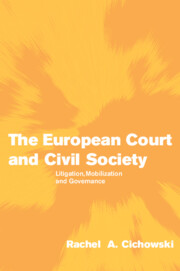Book contents
- Frontmatter
- Contents
- List of figures
- List of tables
- Acknowledgments
- 1 Introduction: institutions, organizations and actors
- 2 Overview of institutionalization in the European Union
- Part I Institutionalization through litigation
- 3 The European Court of Justice and the expansion of gender equality rights
- 4 Environmental protection, non-compliance and judicial politics
- Part II Institutionalization through mobilization
- References
- Index
3 - The European Court of Justice and the expansion of gender equality rights
Published online by Cambridge University Press: 22 September 2009
- Frontmatter
- Contents
- List of figures
- List of tables
- Acknowledgments
- 1 Introduction: institutions, organizations and actors
- 2 Overview of institutionalization in the European Union
- Part I Institutionalization through litigation
- 3 The European Court of Justice and the expansion of gender equality rights
- 4 Environmental protection, non-compliance and judicial politics
- Part II Institutionalization through mobilization
- References
- Index
Summary
In 1958, women's rights were not on the agenda for the newly forming European Economic Community. However, some national governments were concerned with protecting business from unfair competition created by wage disparities, and thus provided that under the Treaty of Rome men and women would receive equal pay for equal work (Article 141). This provision was intended to bestow obligations on national governments and to prevent competition distortion. Today this same social provision bestows a positive right on individuals throughout the member states, a judicially enforceable right that remains the backbone of an expanding net of European gender equality rights: from equal treatment in employment to maternity leave. This dynamic transformation is the focus of this chapter. In particular, I explore the European Court of Justice's (ECJ) social provisions case law pursuant to Article 234 to examine how processes of institutionalization through litigation influenced this policy evolution.
As argued in Chapter 2, the institutionalization of supranational governance through litigation results as a product of multiple processes. I explore these in turn. The first part of the chapter involves quantitative analyses of these processes: factors influencing the legal claim, the litigation and subsequently the effects of the Court's judicial rulemaking. In the second part of the chapter, I supplement this quantitative data with an in-depth case law analysis of a single sub-field of the social provisions policy domain: pregnancy and maternity rights. This provides greater detail to the general patterns highlighted in the quantitative analyses.
- Type
- Chapter
- Information
- The European Court and Civil SocietyLitigation, Mobilization and Governance, pp. 73 - 118Publisher: Cambridge University PressPrint publication year: 2007



